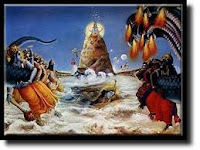“Lord Kalki will appear in the home of the most eminent Brahmana
of Shambhala village, the great soul Vishnuyasha.”
“At the end of Kali-yuga, when there exist no topics on the
subject of God, even at the residences of so-called saints and respectable gentlemen
of the three higher varnas [ and
when the power of government is transferred to the hands of ministers elected
from the lowborn Shudra class or those less than them, and when nothing is
known of the techniques of sacrifice, even by word, at that time the Lord will
appear as the supreme chastiser.”
“At that point of time there
will be chaos on earth. Everywhere the undesirable activities of the thieves
and plunderers would be on the increase. . . At that point in time, in the
house of a Brahmana named Vishnuyasha, Narayana shall appear in one of his rays
in the form of the great Kalki as the son of that Brahmana. He will be mounted
on a very big horse and holding a sword in his hand, he shall destroy all
the mlecchas [wicked, selfish and low-minded people]
on earth. Thus, the earth would be rid of the mlecchas, after
which he will disappear.”
Lord Parasurama, as Kalki’s teacher, explains
to Lord Kalki after His training what His mission will be: “You have learned
the art of discharging arrows from Me. You will imbibe transcendental knowledge
from Shukadeva Gosvami, and You will be awarded a powerful weapon by Lord
Shiva. Thereafter, You will marry a woman named Padma from the island of
Simhala [Sri Lanka]. Your mission is to re-establish Sanatana-dharma. Thereafter, You will set out to
conquer the entire world and in the course of that conquest, You will defeat
many sinful kings who are representatives of Kali. You will also annihilate
many followers of Buddhism and finally, You will entrust the responsibility of
ruling the world to Devapi and Maru.”
After Lord Kalki had removed
all of the nefarious and wicked kings, rulers, and people, and the atheist
religions had also been abolished for the real spiritual process of Sanatana-dharma, Lord Kalki returned from His
wanderings over the planet to remain in the village of Shambhala. The Kalki Purana (32.2-5) explains, “Lord Kalki
continued to reside in the village of Shambhala, along with His brothers, sons,
other relatives and associates, for one thousand years. The entire village of
Shambhala, which was as good as the heavenly planets, appeared very beautiful
with its assembly houses, gates, raised platforms, and flags flapping in the
breeze that has been placed here and there. Anyone who gave up his material
body in Shambhala was freed from all sinful reactions and awarded shelter at
the lotus feet of Lord Kalki. Thus, the village of Shambhala, which was
profusely decorated with blooming flowers, pious trees, forests and gardens,
became a holy place that granted liberation from material existence.”




















